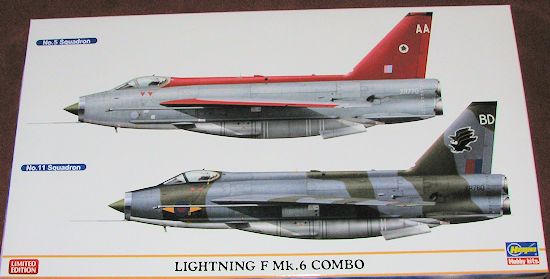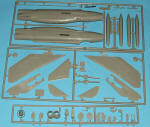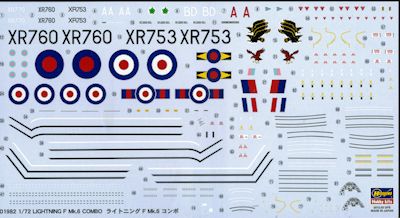
Hasegawa 1/72 Lightning F.6 Combo
| KIT #: | 01982 |
| PRICE: | $19.99 on sale ($39.99 SRP) |
| DECALS: | Three options |
| REVIEWER: | Scott Van Aken |
| NOTES: | Two complete kits |

| HISTORY |
The last supersonic single seat fighter developed by the British and put into unit service was the BAC/E.E. Lightning. Though not built in large numbers, the type has etched itself into the consciousness of aviation fans all throughout the UK. A maintenance nightmare according to those who worked on it, the aircraft was, nevertheless, quite capable and extremely fast. In fact, its speed was a major plus for an interceptor in the UK when the warning time was minimal. It was also quite fuel thirsty and was often seen with its somewhat unique over-wing fuel tanks. This odd arrangement has been used on a few other aircraft for weapons, but to my knowledge, no other aircraft has routinely carried them in this fashion. Though the type was withdrawn from service in the late 1980s, several still operate in the UK doing fast taxy demonstrations and I believe at least one is airworthy in South Africa. The British aviation authorities will not allow private flying of the Lightning due to the ease at which the control surface hydraulic lines could easily be switched by accident and the lack of manual back-up. Then there is the problem with general maintenance, but the flight control deal that has kept them grounded.
The F.6 is basically an upgrade of earlier variants. The major difference is the enlarged belly tank that includes the cannon armament, removing that from the nose where it was in earlier versions, and a larger, square-tipped fin. Also added to this version were the ability to carry over-wing fuel tanks. These aircraft operated the Red Top missiles. Along with the F.3 versions, that were modified F.1A/F.2 aircraft with smaller belly tanks, the F.6 was the last of the Lightnings to serve with the RAF and the only ones to be camouflaged in the greys scheme.
| THE KIT |
 The Lightning is in what many of us will call the 'first generation' of
Hasegawa kits. These were characterized by nearly non-existent cockpits,
very thick plastic and the then-in-vogue raised surface detailing.
Dimensionally, these are accurate kits, but suffer by comparison simply by
being probably 40 year old technology. If you want the standard, modern,
fiddly kit, then seek out the Trumpeter version.
The Lightning is in what many of us will call the 'first generation' of
Hasegawa kits. These were characterized by nearly non-existent cockpits,
very thick plastic and the then-in-vogue raised surface detailing.
Dimensionally, these are accurate kits, but suffer by comparison simply by
being probably 40 year old technology. If you want the standard, modern,
fiddly kit, then seek out the Trumpeter version.
The smaller parts have ejector pin marks that you'll have to remove and
there is some flash on these pieces, though not as much as one would have
thought. There is no intake or exhaust trunking, no wheel well detail and
though a basic cockpit and pilot are given, the accuracy of the cockpit
leaves a lot to be desires. Fortunately, for those wishing to build this
kit, aftermarket is available. One of the first times I ever used etched
brass was with
this kit
some 25 years back. The two piece windscreen/canopy is well molded and
pretty clear as well.
Instructions
date from 1989, though the kit itself has to be from about 1971, and provide
the usual Gunze only color references, requiring some mixing of external
colors. Fortunately, these shades are all available pre-mixed using other
brands of paint. This boxing provides two complete kits and offers three
markings options, each in a different scheme as worn by the F.6.
The two options shown on the box art are the red
tailed aircraft from 5 squadron in one of the greys schemes last worn. This is
from 1987, which was probably the last year that 5 Squadron flew the type.
 This special
scheme for the squadron commander also has the leading edge of the wings in red.
Next is a camouflaged aircraft of 11 Squadron, which I believe was the last
operational squadron. This is from 1983 and while the camo wraps around the
leading edge of the wings, is not a full wrap around scheme. Finally, from 1975,
one of the first years of the F.6 is this bare metal with white tail version
from 23 Squadron. The decals are very nicely done with whites that are actually
white. There are data markings for all three different options.
This special
scheme for the squadron commander also has the leading edge of the wings in red.
Next is a camouflaged aircraft of 11 Squadron, which I believe was the last
operational squadron. This is from 1983 and while the camo wraps around the
leading edge of the wings, is not a full wrap around scheme. Finally, from 1975,
one of the first years of the F.6 is this bare metal with white tail version
from 23 Squadron. The decals are very nicely done with whites that are actually
white. There are data markings for all three different options.
| CONCLUSIONS |
While an admittedly basic kit by today's standards, it is accurate and if you don't let yourself get carried away with AMS, can be rather quickly built into a very nice model. It will need nose weight if building it on its wheels. Actually, this kit would make for an excellent stand model as the gear doors actually fit in the closed position and you won't have to sweat detailing a pretty bleak cockpit! Oh yes, if you don't like the included markings options, there have been decal sheets done over the years that will pretty much allow any of the F.6 units to be reproduced.
| REFERENCES |
Wikipedia
December 2013
Thanks to, well, me
for the preview kit. If you would like your product reviewed fairly and
fairly quickly, please
contact
the editor
or see other details in the
Note to
Contributors.